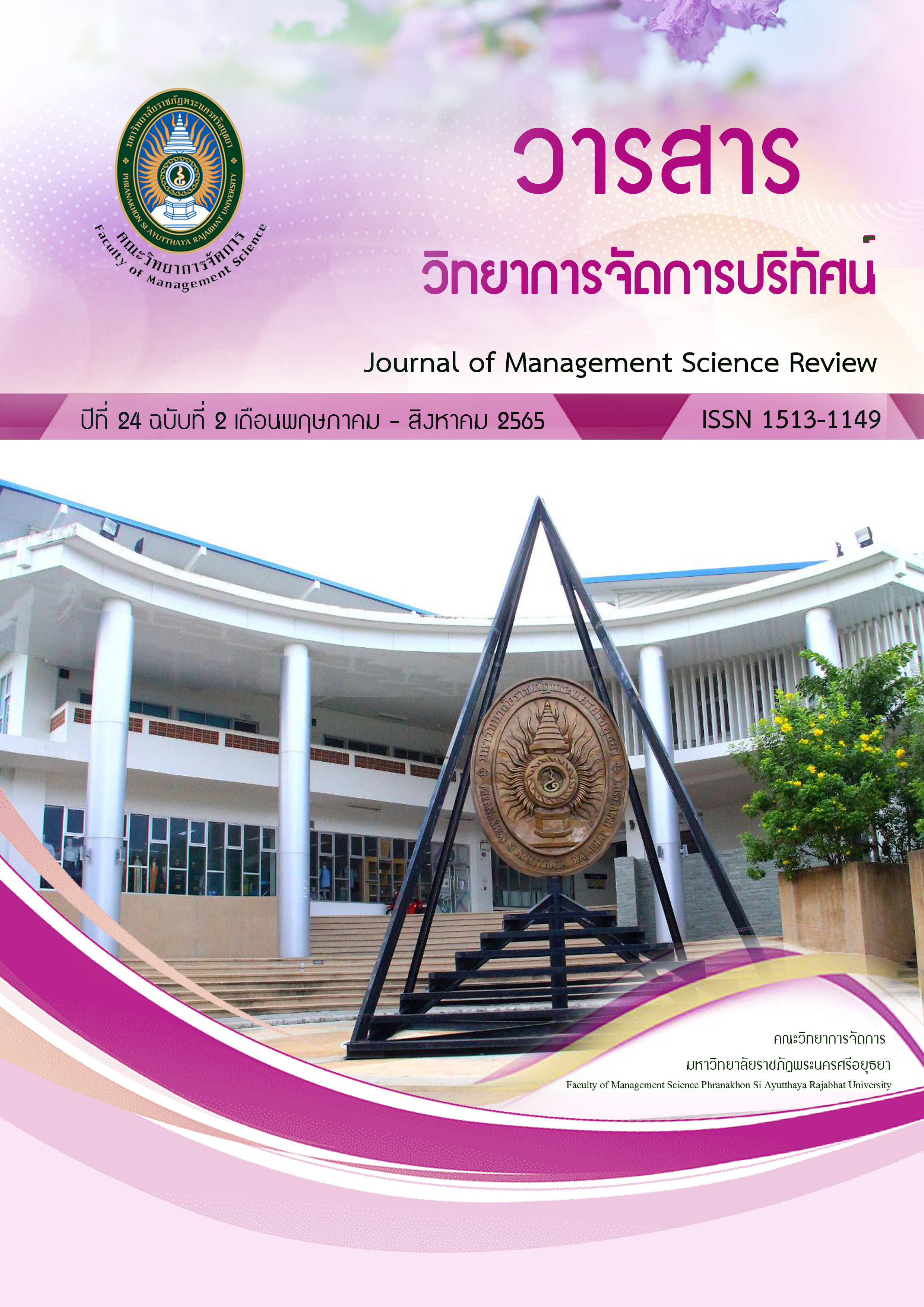การปรับตัวธุรกิจร้านอาหารภายหลังวิกฤตโควิด-19
คำสำคัญ:
ธุรกิจร้านอาหาร, การปรับเปลี่ยน, พฤติกรรมปรกติใหม่, โควิด-19บทคัดย่อ
สถานการณ์การแพร่ระบาดของไวรัสโควิด-19 มีผลกระทบต่อธุรกิจร้านอาหารเป็นอย่างมาก เนื่องจากมาตรการรณรงค์งดออกนอกบ้านหากไม่จำเป็น บทความวิชาการนี้จึงมีวัตถุประสงค์เพื่อนำเสนอการปรับตัวทางของธุรกิจร้านอาหารภายใต้สถานการณ์ปรกติใหม่ เนื่องจากวิกฤตการณ์การแพร่ระบาดครั้งนี้ส่งผลให้มูลค่าธุรกิจร้านอาหารระหว่างปี 2563 ถึง 2564 ลดลง ร้อยละ 11 ทำให้ผู้ประกอบการต่าง ๆ จำเป็นต้องมีการปรับตัวของธุรกิจเพื่อตอบสนองการปรับเปลี่ยนไปของพฤติกรรมผู้บริโภค ดังนั้นในการปรับตัวของธุรกิจร้านอาหารภายใต้สถานการณ์ปรกติใหม่ ผู้ประกอบการควรมีการวางแผนเพื่อเตรียมพร้อมในการรับมือกับวิกฤตต่าง ๆ มีการสื่อสารในภาวะวิกฤต มีการฝึกอบรมให้ความรู้กับพนักงาน นอกจากนี้ประผู้ประกอบการยังควรให้ความสำคัญกับการยกระดับมาตรฐานของธุรกิจให้สอดคล้องกับสถานการณ์ปรกติใหม่ เช่น การรักษาความสะอาดและความปลอดภัยของอาหาร การให้บริการลูกค้าที่ลดการสัมผัส มีการร่วมมือกับแพลตฟอร์มการสั่งอาหารออนไลน์ การสื่อสารทางการตลาดที่เน้นมาตรฐานการให้บริการตามวิถีปรกติใหม่ และควรสำรวจพฤติกรรมของผู้บริโภคที่มีต่อธุรกิจร้านอาหาร เพื่อจะได้ติดตามรูปแบบพฤติกรรมการซื้อหรือการบริโภคของลูกค้ากลุ่มเป้าหมาย และนำมาพัฒนารูปแบบการดำเนินธุรกิจให้สอดคล้องกับความต้องการของผู้บริโภคได้อย่างมีประสิทธิภาพและเกิดความยั่งยืนในการดำเนินธุรกิจ
เอกสารอ้างอิง
กรมสรรพากร. (2564). คู่มือภาษีเงินได้บุคคลธรรมดา สำหรับผู้ประกอบการ SME ที่เข้าร่วมโครงการคนละครึ่ง. ค้นเมื่อ 10 กุมภาพันธ์ 2565, จาก https://www.rd.go.th/
fileadmin/user_upload/SMEs/infographic/guideline50_50.pdf
กระทรวงการคลัง. (2565). สิ้นสุดการใช้จ่ายมาตรการลดภาระค่าครองชีพและฟื้นฟูเศรษฐกิจจากผลกระทบ COVID-19 ปี 2564. ค้นเมื่อ 9 กุมภาพันธ์ 2565, จาก https://www.mof.go.th/index.php/th/view/attachment/file/3136353234/ข่าวแถลงกระทรวงการคลังฉบับที่%201-2565%20%28สิ้นสุดการใช้จ่ายมาตรการลดภาระค่าครองชีพและฟื้นฟูเศรษฐกิจจากผลกระทบ%20COVID-19%20ปี%202564%29.pdf
กรุงเทพธุรกิจ. (2564). อัพเดท 'ยิ่งใช้ยิ่งได้' ให้สิทธิ์ e-Voucher 7,000 บาท ใช้อย่างไร ใครได้สิทธิ์บ้าง ?. ค้นเมื่อ 9กุมภาพันธ์ 2565, จาก https://www.bangkokbiznews.com/social/946230
ฐานเศรษฐกิจ. (2564). เปิดเกณฑ์เยียวยานักดนตรี ผู้ประกอบการผับ-บาร์ เช็คที่นี่. ค้นเมื่อ 11 กุมภาพันธ์ 2565, จาก https://www.thansettakij.com/economy/505655
โณธิตา หวานชื่น, วรุตม์ นาฑี และศุภรัตน์ พิณสุวรรณ, (2564). ผลกระทบโควิด 19 และการปรับตัวของผู้ประกอบการค้าขายในตลาดเก็นติ้ง บริเวณพื้นที่ชายแดน ตำบลสุไหงโก-ลก อำเภอสุไหงโก-ลก จังหวัดนราธิวาส. ค้นเมื่อ 10 กุมภาพันธ์ 2565, จาก http://www2.huso.tsu.ac.th/NCOM/GEOGIS2021/FULL_PAPER/PDF20211024215536_1.pdf
The Standard. (2563). #Saveสตรีทฟู้ด เมื่อโควิด-19 ทำชีวิตเปลี่ยน ถึงเวลาร้านอาหารข้างทางต้องปรับตัวฝ่าวิกฤตไปด้วยกัน. ค้นเมื่อ 15 กุมภาพันธ์ 2565, จาก https://thestandard.co/dtac-save-street-food-during-coronavirus/
ตลาดหลักทรัพย์แห่งประเทศไทย. (2565). ข้อมูลรายบริษัท/หลักทรัพย์. ค้นเมื่อ 9 กุมภาพันธ์ 2565, จาก https://www.set.or.th/set/
commonslookup.do?language=th&country=TH
ธนาคารแห่งประเทศไทย. (2563). มาตรการเลื่อนกำหนดชำระหนี้. ค้นเมื่อ 9 กุมภาพันธ์ 2565, จาก https://www.bot.or.th/ covid19/content/sme/paymentholiday/Pages/default.aspx
ประชาชาติ. (2565). ร้านค้าเลิกรับ คนละครึ่งเฟส 4 โอดถูกเก็บภาษีเพิ่มหลักหมื่น. ค้นเมื่อ 10 กุมภาพันธ์ 2565, จาก https://www.prachachat.net/finance/news-861335
ไทยรัฐ. (2565). คาดราคาหมูตลอดปี 65 จะอยู่ที่กิโลละ 190-220 บาท เนื้อไก่จะแพงขึ้นด้วย.
ค้นเมื่อ 10 กุมภาพันธ์ 2565, จาก https://www.thairath.co.th/business/feature/2282465
Positioning. (2564). ศึกฟรีหม้อไม่จบ! ห้างฯ เปิดแล้วแต่ชาบู-ปิ้งย่างยังจัดโปรฯ “หม้อฟังก์ชันล้ำ” โกยลูกค้าเดลิเวอรี่. ค้นเมื่อ 9 กุมภาพันธ์ 2565, จาก https://positioningmag.com/1287523
Marketeer. (2564). เจาะอินไซด์ Food delivery มีโอกาสเติบโตมากแค่ไหน. ค้นเมื่อ 12 กุมภาพันธ์ 2565, จาก https://marketeeronline.co/archives/238462
เราเที่ยวด้วยกัน. (2565). โครงการเราเที่ยวด้วยกัน. ค้นเมื่อ 10 กุมภาพันธ์ 2565, จาก https://www.เราเที่ยวด้วยกัน.com/
วิรัลพัชร ประเสริฐศักดิ์. (2565). แนวคิดและคำนิยามของความมั่นคงทางอาหาร. ค้นเมื่อ 23 กุมภาพันธ์ 2565, จาก http://www.polsci.tu.ac.th/fileupload/36/24.pdf
ศูนย์วิจัยกสิกรไทย. (2565). ธุรกิจร้านอาหารปี 65 คาดพลิกกลับมาฟื้นตัวร้อยละ 5.0 – 9.9 การแพร่ระบาดของ Omicron และต้นทุนวัตถุดิบยังคงเป็นความท้าทายสำคัญ (กระแสทรรศน์ ฉบับที่ 3299). ค้นเมื่อ 10 กุมภาพันธ์ 2565, จาก https://www.kasikornresearch.
com/th/analysis/k-con/business/Pages/
restaurant-z3299.aspx
สถาบันวิจัยเพื่อการพัฒนาประเทศไทย. (2563). วิเคราะห์มาตรการช่วยเหลือด้านสินเชื่อสำหรับลูกหนี้รายย่อยที่ได้รับผลกระทบจาก COVID-19 ระยะที่ 1 และ 2 โดยธนาคารแห่งประเทศไทย. ค้นเมื่อ 9 กุมภาพันธ์ 2565, จาก https://tdri.or.th/2020/03/covid-7/
สมชัย จิตสุชน. (2564). ผลกระทบทางสังคมของการระบาดโรคโควิด-19 ระลอกใหม่และมาตรการที่ควรมี. ค้นเมื่อ 6 สิงหาคม 2565, จาก https://tdri.or.th/2021/01/impact-of-new-covid-19-wave/
เสาวณี จันทะพงษ์ และทศพล ต้องหุ้ย. (2565). ผลกระทบวิกฤต COVID-19 กับเศรษฐกิจโลก: This Time is Different. ค้นเมื่อ 10 กุมภาพันธ์ 2565, จาก https://www.bot.or.th/Thai/ResearchAndPublications/articles/Pages/Article_18Mar2020.aspx
เสาวณีย์ ตรีรัญเพชร, ศุภรัตน์ พิณสุวรรณ และวราภรณ์ ทนงศักดิ์. (2564). สภาพการณ์และการปรับตัวของผู้ประกอบการร้านอาหารในพื้นที่ตำบลเกาะยอ อำเภอเมืองจังหวัดสงขลา.
ค้นเมื่อ 11 มีนาคม 2565, จาก http://www2.huso.tsu.ac.th/NCOM/GEOGIS2021/FULL_PAPER/PDF20211024221501_1.pdf
สำนักงานบริหารหนี้สาธารณะ. (2564). มาตรการเยียวยาแรงงาน-ผู้ประกอบการเพิ่มเติม (ม.33, ม.39, ม.40 และ 9 กลุ่มอาชีพ). ค้นเมื่อ 10 กุมภาพันธ์ 2565, จาก https://www.pdmo.go.th/pdmomedia/documents/2021/Jul/มาตรการเยียวยาแรงงาน.pdf
สำนักงานประชาสัมพันธ์กรุงเทพมหานคร. (2565 ก). เข้าถึงได้จาก ประกาศกทม. เรื่อง สั่งปิดสถานที่เป็นการชั่วคราว ฉบับที่ 49. ค้นเมื่อ 19 กุมภาพันธ์ 2565, จาก https://www.prbangkok.com/th/covid/detail/19/8922
_______. (2565 ข). ประกาศกทม. เรื่อง สั่งปิดสถานที่เป็นการชั่วคราว ฉบับที่ 47. ค้นเมื่อ 19 กุมภาพันธ์ 2565, จาก https://www.prbangkok.com/
th/covid/detail/19/7321
Agarwal, M. & Rao, V. (1996). An Empirical Comparison of Consumer-Based Measures of Brand Equity. Marketing Letters, 7(3), 237-247.
Hodges, P. & Richardson, J. (2011). Boom, Gloom and The New Normal. ICIS publication.
Porter, M. E. (1998). Competitive Strategy: Techniques for Analyzing Industries and Competitors. USA: Illustrated edition.
Kotler, P. & Armstrong, G. (2009). Marketing, an Introduction. New Jersey: Pearson Prentice Hall.
Roy, C. and Andrews, H. A. (1999). The Roy’s Adaptation Model. Stamford: Appleton & Lange.





